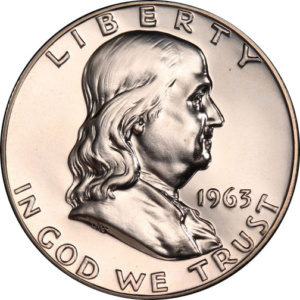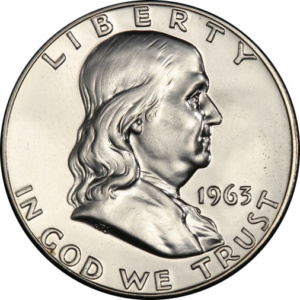The Proof Franklin Half Dollar is a beautiful collectible coin. Ben Franklin is a fascinating character from early American history, and his enshrinement on the obverse of the 90% silver U.S. Half Dollar from 1948 to 1963 makes it incredibly popular to collectors.
Let’s have a look at Brilliant Proof Franklin Half Dollars. Don’t confuse Brilliant Proofs with Cameo or Deep/Ultra Cameo Proof coins with some satiny “white” appearance on the devices in contrast with the mirrored fields. These coins are beautiful mirrors all the way across the coin. Cameo and Deep or Ultra Cameo Proofs are also extremely popular with coin collectors, but they are much more scarce and therefore much more expensive.

Franklin Half Dollar, PCGS Brilliant Proof 67. PCGS Price Guide: $60. NGC Price Guide: $55. Average eBay Sale of Coin Certified Proof 67: $23
Should you Get your Coin Certified?
Possibly. If you feel it is a high grade piece, or if it has substantial cameo in its strike and it is very pretty, there’s a chance you should have the coin certified. Uncertified, Proof Franklin Halves (especially brilliant proofs, as discussed here) are typically traded for their silver bullion value. On any given day, that’s between $3 and $6, depending on the price of silver. This category includes almost all Franklin Half Dollars.
However, a Franklin Half Dollar in extremely high gem proof grade is extremely valuable once certified. Values can reach into the hundreds or even tens of thousands of dollars per coin. How do you tell the difference between a $5 Proof Franklin Half, a $50 Franklin, a $500 Franklin and a $5000 Proof Franklin Half Dollar? It’s all about the coin grade. Typically these coins come problem-free. However, any scratches or signs of polishing ruin their value completely.
We’ll start with 1963 silver half dollars (Franklins) certified (Brilliant) Proof 67. We’ll look at coins graded by the two major TPGs: PCGS and NGC.
1963 Franklin Half Dollars graded Proof 67 are not rare coins. Most 1963 Franklin Half Dollars fall under the category of coins valued under $100. Brilliant Proof 67 coins are certainly in that category. Between the two top grading companies, collectors and dealers certified over 15,000 coins at this grade level through the years. In contrast, PCGS and NGC certified fewer than 1,000 Proof Deep or Ultra Cameo examples.
CAC accepts Franklin Half Dollars. There are very few CAC coins because at this grade level, coins are prevalent enough to demand in the $20 to $40 range. The cost of certification with shipping is often more than the numismatic value of the coin. As a result, very few dealers will invest more time and money sending these coins to CAC for a sticker.
So which grading company is better for 1963 Franklin Half Dollars graded Proof 67?
After a brief review of eBay sales, it’s “Frankly” a wash.
In general, PCGS-graded Franklin Half Dollars get slightly more bids than NGC-graded coins. Even so, sale values are about the same: around $23.
Oddly, price guides across the board are extremely high for the 1963 Proof Franklin Half Dollar. PCGS Price Guide lists the coin in Brilliant Proof 67 at $60. NGC isn’t much better, listing at $55. Numismedia FMV is slightly more realistic, listing the retail price at $40. The venerable Red Book doesn’t list a price for Proof 67, but shows Proof 65 coins to have a retail price of $26.
But what is reality?
Looking at recent eBay sales for 1963 Proof Franklin Half Dollars graded (Brilliant) Proof 67, in the past few weeks there have been 8 NGC coins which sold at auction with multiple bids and 5 PCGS coins. The most expensive NGC coin sold for $27 plus shipping, while the least only attracted $18. The most expensive PCGS coin managed a whopping $46, while the least expensive was $20.
On average, the NGC coins had 11 bids placed while the PCGS coins garnered an average of 12.6 bids. The average sale price of the NGC coins was $23.75, while the average sale price of the PCGS coins was $27.20.
This might lead you to believe that PCGS coins sell for more. They really don’t. Throwing out the highest and lowest sale price coins, NGC sale prices averaged $24.17 and 10 bids, while PCGS coins of the same grade brough $23.30 on average with, yet, 12.6 bids.
Indubitably, the PCGS coins are more liquid, attracting more bids. However, the end sale prices ended up very similar. Accounting for differences in shipping, these common coins sell for about the same prices, albeit well below any published price guide.
None of the recently-sold coins that we reviewed for this article were toned, artificially or naturally. An incredibly beautiful, naturally toned coin in a PCGS or NGC holder (particularly NGC star) should garner much, much higher sale prices. These prices will be in proportion to their beauty. Recent proofs like this are hard to find naturally toned.
Cost to Certify
If you’re already a member of PCGS, unless you’re certain your Brilliant Proof Franklin Half Dollar will Proof 68 or 69, PCGS is an expensive way to get this coin certified. The cost of PCGS annual membership is close to $200 annually and includes four vouchers for certification for coins like this – but that $200 does not include shipping and insurance costs of at least $20 per submission. This high cost of certification is the likely reason that most 1963 Proof Franklin Half Dollars have been certified by NGC (NGC population of 1963 Proof Franklin Half Dollar Proof 67: 13,000+, PCGS population: 3,000+).
If you’re already a member of NGC (membership cost is $25 and does not include grading fees of around $40 – $50, including shipping), this is an expensive coin to get certified today. Again, if you’re certain the coin will come back with a Cameo or Ultra Cameo designation, or if you’re certain the coin will grade Proof 68 or higher, it might be worth the risk.
If you’re unsure, it’s best just to hold on to the coin for now, or be prepared to sell it for bullion, raw (uncertified.)
Besides the fact that the coin needs to grade higher than 67 to be worth certification is the fact that grading proofs can be difficult for novice numismatists.

Silver Franklin Half Dollar, PCGS (Brilliant) Proof 64
As you can see by the pictured coins, one Proof 67 and one Proof 64, the coins are virtually indistinguishable with these beautiful, professionally taken photographs. PCGS Price Guide was well over at $60 for Proof 67, so when you see that PCGS Price Guide for Proof 64 is $19, you can imagine the real sale prices. If you have a deep cameo proof in high grade, certification probably makes sense.
That said, you never know what the future might bring. Brilliant Proof Franklin Half Dollars are unquestionably beautiful coins, and when you look at one in person there is no question whatsoever – for the Franklin enthusiast at least – that trading a Jackson greenback for a certified high-grade example is a modest and favorable swap.
